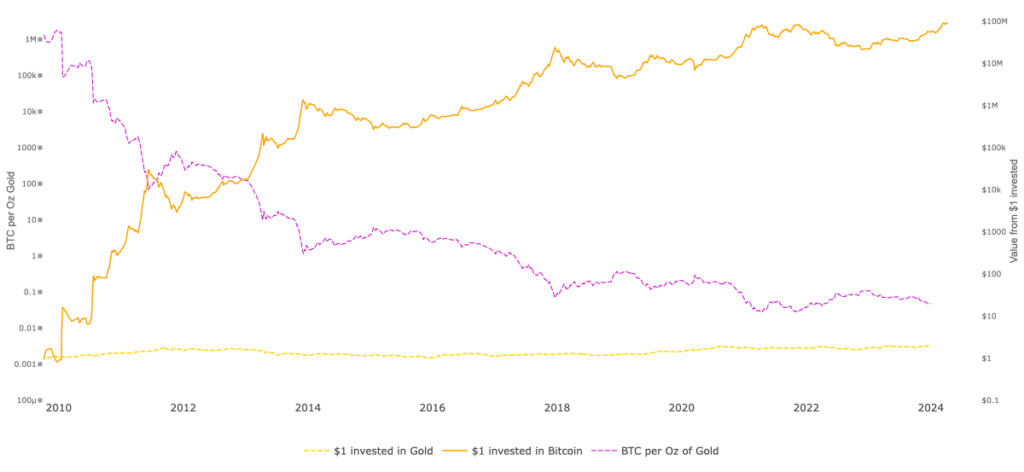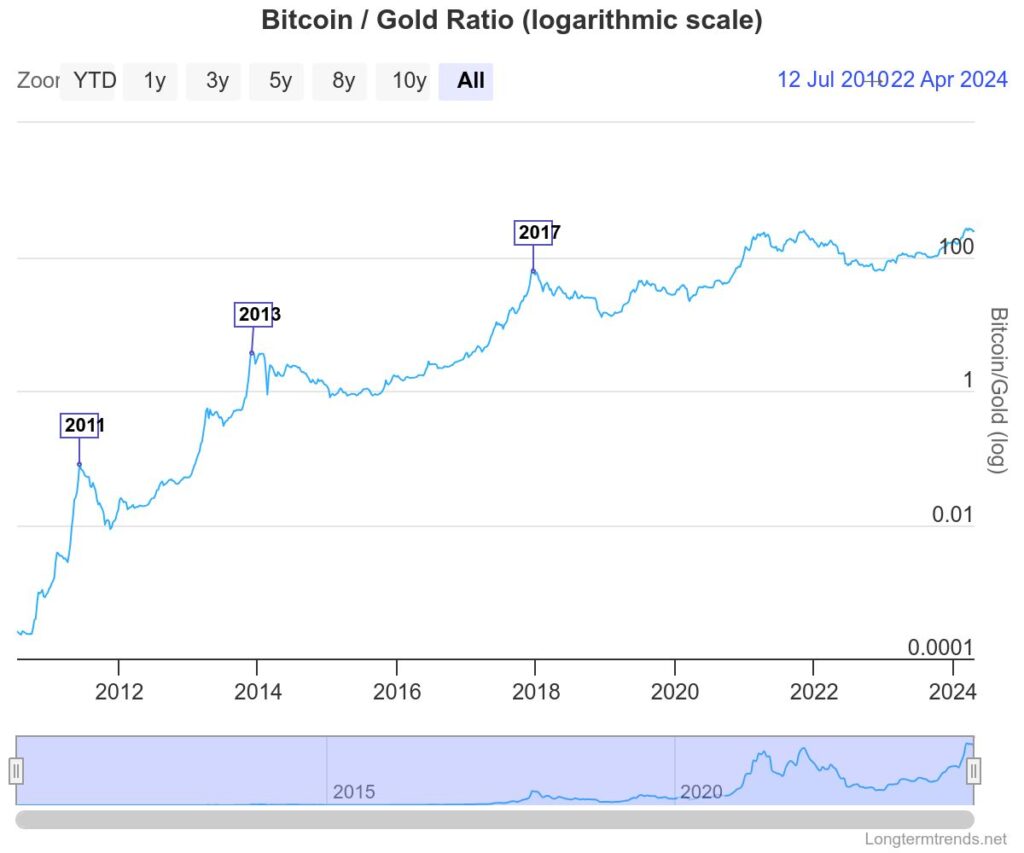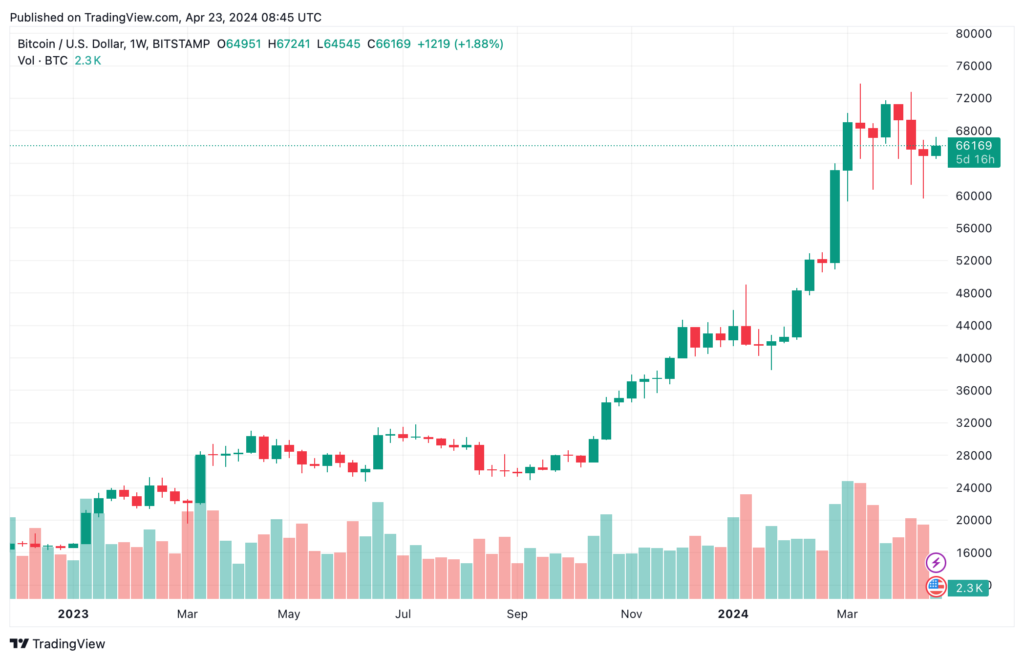In this article, we look at the fascinating world of Bitcoin through a detailed analysis of several key aspects that define its current position and future prospects in the financial sector. Each chapter is dedicated to a specific topic that together paints a comprehensive picture of Bitcoin’s evolution and its potential role in the global economy.
Throughout these chapters, we aim to provide a clear and in-depth understanding of Bitcoin, clarify its position in the financial system and provide an outlook on its potential future.
The Correlation Between Bitcoin and Gold
The correlation between Bitcoin and gold is an essential indicator for investors looking at the stability and growth of their portfolios in the context of global economic fluctuations. Specific comparative metrics are used in the valuation of these two assets, such as the price of Bitcoin measured in gold. This allows a direct comparison of the performance independent of fluctuations in fiat currencies such as the US dollar.
Price development of Bitcoin in relation to Gold

$1 invested in Bitcoin vs. $ invested in gold
Historical data shows that the price of Bitcoin, measured in gold, has fluctuated significantly. At the time of the last analysis, the price of one Bitcoin was approximately 35 ounces of gold. This figure is based on the highs of 2021, when Bitcoin reached a particularly high valuation. The current data suggests that this peak has not yet been reached again, partly due to gold’s strong recent performance.
Quantitative analysis of the Bitcoin-Gold ratio

Bitcoin/gold ratio logar chart
In more detail, the correlation between Bitcoin and gold is expressed by looking at their respective prices in ounces. For example, a chart shows that over the last few years, despite the price volatility of Bitcoin in US dollars, the value of a Bitcoin in gold has steadily increased. This indicates an increasing acceptance and greater value recognition of Bitcoin relative to gold, even as the traditional volatility of crypto assets remains
Market implications of this correlation
Analyzing the price correlation of Bitcoin to gold is not only of academic interest, but also has practical market implications. Investors use this information to better manage the risk to reward ratio between these two asset classes. A rising Bitcoin price in gold terms can be interpreted as an indicator of increasing risk appetite in the markets, while a falling value indicates risk aversion.
To summarize, the correlation between Bitcoin and gold is a complex phenomenon that is influenced by various economic and market-specific factors. The fact that Bitcoin, despite its relative newness to the market, is able to occupy such a significant position relative to established gold is a strong indication of its increasing relevance as an investment asset. Ongoing monitoring of this correlation will be of great interest to investors in order to better understand the dynamics of global financial markets and make more effective investment decisions.
Market Cycles and Performance of Bitcoin
Analyzing Bitcoin’s market cycles is crucial to understanding past performance patterns and predicting future movements. Bitcoin shows clear patterns in four-year cycles that are closely linked to halving events, which occur every four years and halve the reward for mining.
Historical performance and four-year cycles
A historical view of Bitcoin performance reveals regular cycles that span roughly four years. These cycles include a phase in which returns are particularly high after a halving, followed by a relative cooling of the market. For example, in 2014, 2018 and 2022, low points in returns were identified that corresponded to the year after a halving. There were strong upward movements in each of the following years.
Average returns and annual performance
Since 2011, Bitcoin has averaged a return of around 150% per year, making it the best performing asset class since its inception. This high average return demonstrates the exceptional market acceptance and growth of Bitcoin as an asset class. However, annual returns vary considerably, and it can be seen that particularly high returns were achieved in the first few years after its launch.
Performance in 2023

Bitcoin performance 2023
The year 2023 was particularly outstanding for Bitcoin in terms of recent performance. This illustrates Bitcoin’s ability to generate significant gains even in more mature phases of its market cycle. The first quarter of this year 2024 was also strong, indicating continued positive momentum.
Regional differences in performance
Interestingly, Bitcoin’s performance also shows regional differences. In 2023, for example, performance was strongest in Swiss francs, which could be due to local economic factors. Similar patterns were observed in other currencies such as the Japanese yen and the US dollar, with the US dollar showing one of the weaker performances.
The cyclical nature of Bitcoin’s market performance, amplified by the halving event, provides a unique investment window that presents both opportunities and risks. Investors who understand and take advantage of these cycles can potentially realize high returns while managing the risk associated with Bitcoin’s volatility. Continually monitoring these cycles and regional performance differences will be critical to future strategic decisions. The predictive power of these patterns makes Bitcoin an intriguing, albeit challenging, investment target.
Volatility and its Impact on Bitcoin
Volatility is a characteristic feature of Bitcoin and plays a central role in the investment strategy of investors. This chapter examines the fluctuations in the price of Bitcoin, their causes and the resulting impact on the market.
Definition and measurement of volatility
Volatility refers to the rate at which the price of Bitcoin rises or falls. It is typically measured as the standard deviation of logarithmized daily returns. A higher volatility value indicates a riskier investment environment, as larger price fluctuations can be expected.
Historical volatility patterns
Bitcoin has experienced significant volatility throughout its history. For example, data over the last five years has shown a trend of decreasing volatility, but still higher than most traditional asset classes. Realized volatility, measured over rolling 30-day windows, shows that there have been periods where volatility has increased, followed by periods of relative stability.
Implied vs. realized volatility
The distinction between implied and realized volatility is essential for understanding market expectations. Implied volatility, derived from the prices of Bitcoin options, indicates market expectations regarding future fluctuations. It generally increases when market participants expect larger price movements, whether due to upcoming events or growing uncertainty in the market. Realized volatility, on the other hand, measures the actual price fluctuations that have already taken place.
Analysis of volatility trends
An interesting trend has been observed in recent years: While periods of price appreciation were often accompanied by high implied volatility, realized volatility showed both upward and downward trends. This discrepancy can be attributed to different perceptions and reactions of market participants to risks. For example, high implied volatility may indicate an expected negative development, which may not necessarily materialize.
Effects of volatility on investment strategies
The high volatility of Bitcoin has a significant impact on investment strategies. It requires investors to actively manage risk, which includes buying at low prices and selling at high prices in order to profit from the sharp price fluctuations. In addition, experienced investors use complex financial instruments such as options to hedge their positions and generate additional returns by trading the volatility itself.
Bitcoin’s volatility is both a challenge and an opportunity for investors. It offers the opportunity for above-average gains, but also carries a high risk of loss. Investors who understand the mechanics of Bitcoin volatility and use the right tools to mitigate risk can use this characteristic to their advantage. Continued analysis and understanding of volatility trends will therefore be crucial to making effective investment decisions in the world of crypto assets.
The Future of Bitcoin and the Halving
Halving is a key event in the economics of Bitcoin that occurs every four years and halves the reward for mining a block. This mechanism is built into Bitcoin’s protocol to prevent inflation and increase the scarcity of the currency. The implications of halving are profound, both in terms of expected price performance and the overall economics of Bitcoin.
What is halving?
The Halving reduces the rate at which new Bitcoins are generated through mining by halving the rewards for miners. This event occurs every 210,000 blocks, which happens approximately every four years. The next halving will reduce the reward from 6.25 to 3.125 bitcoins per block. This artificial scarcity has potentially inflation-dampening effects and is often seen as a bull market trigger.
Historical contextualization and its effects
The previous halvings (2012, 2016, 2020) were each harbingers of significant bull markets. The reduction in supply with demand remaining the same or increasing led to significant price increases within the 12 to 18 months following each halving. After the 2020 halving, Bitcoin reached its highest value to date in 2021 in November, but this was surpassed in 2024 by the introduction of Bitcoin Spot ETFs even before the next halving. This underlines the hypothesis that halvings are key turning points in Bitcoin’s financial cycle.
Forecasts based on the halving
The reduction in new Bitcoin supply affects the stock-to-flow ratio (ratio of existing to new units), a model traditionally used to value precious metals such as gold. Applying this model to Bitcoin suggests that Bitcoin becomes “harder” than gold with each halving. This means that the scarcity of Bitcoin could increase its value in the long term.
Future market cycles and price development
Assuming that the stock-to-flow model continues to provide a reliable predictive basis, the price of Bitcoin could rise sharply again after the next halving. Historical data suggests that the largest price increases begin about a year after each halving and continue until the next cycle. With the further acceptance of Bitcoin as “digital gold”, these cycles could become more pronounced.
Long-term effects on the Bitcoin economy
Halving not only affects the price, but also the security and stability of the Bitcoin network. With decreasing rewards, some miners could stop their operations, which could affect network security in the short term. In the long term, however, rising transaction fees are expected to offset the reduced block rewards.
Halving is a fundamentally important part of Bitcoin’s long-term performance and economics. It not only drives the scarcity and potential value appreciation of Bitcoin, but also actively influences market structures and investment cycles. For investors, understanding this mechanism provides a basis to strategically plan future market movements and positioning within the asset class. The upcoming halvings could see Bitcoin consolidate its position as a leading crypto asset and take an even more central role in the digital economy.
The Market Capitalization of Bitcoin in Comparison
Bitcoin’s market capitalization is an important indicator of its economic importance and how it compares to traditional assets such as gold and global financial markets. This chapter analyzes Bitcoin’s current and potential position in the context of global assets and examines its growth dynamics.
Bitcoin’s current market capitalization
Bitcoin’s market capitalization has fluctuated significantly over the years, but increasingly reflects its adoption and integration into the broader financial ecosystem. At the time of the last full analysis, Bitcoin’s market capitalization was approximately USD 1.4 trillion. This represents a significant share compared to other major asset classes, but lags behind more traditional assets such as gold and US government bonds.
Comparison with gold
Gold, often considered the ultimate “safe haven” investment, has an estimated market capitalization of around USD 15 trillion. This is more than ten times that of Bitcoin. Although Bitcoin is often referred to as the “digital gold”, this comparison shows that there is still room for growth in terms of total market capitalization, especially when considering gold’s historical performance and cultural entrenchment.
Comparison with other assets
The market capitalization of S&P 500 stocks is around $43 trillion, which underscores the size and liquidity of this market. US government bonds, as another example, represent approximately USD 22 trillion of debt securitized as bonds. These figures represent the extent to which Bitcoin needs to grow to achieve comparable market relevance.
Bitcoin’s positioning and potential growth prospects
Despite its currently smaller market capitalization compared to traditional assets, Bitcoin offers unique advantages, such as high liquidity and global accessibility, that differentiate it from physical assets such as gold. If Bitcoin continues to gain widespread adoption and is increasingly integrated into institutional portfolios, its market capitalization could increase significantly, especially considering the limited supply of 21 million coins.
Long-term forecasts
Long-term forecasts for Bitcoin’s market capitalization are optimistic, with some analysts speculating that it could equal or surpass gold in the coming decades, especially when considering factors such as halvings and their impact on Bitcoin’s scarcity. The analogy to gold and its limited availability could lead to Bitcoin reaching a similar or even greater market capitalization than gold, especially in times of financial uncertainty and inflation when investors are increasingly looking for non-traditional reserves.
Bitcoin ETFs and Institutional Adoption
The introduction of Bitcoin Exchange Traded Funds (ETFs) marks a significant milestone in the institutional adoption of Bitcoin. This development not only symbolizes the legitimization of Bitcoin as an investment vehicle, but also greatly facilitates access for institutional and traditional investors who were previously deterred by the technological and regulatory hurdles of buying Bitcoin directly.
Introduction and importance of Bitcoin ETFs
A Bitcoin ETF allows investors to invest in Bitcoin without having to buy and store the crypto asset directly. These funds track the price of Bitcoin and are traded on traditional exchanges, similar to shares. The first approval of a Bitcoin ETF in the US was a significant step as it offered institutional investors the opportunity to invest in Bitcoin in a regulated manner.
Market development and capital flows
Since the launch of the first Bitcoin ETFs, these products have seen significant inflows of funds. By the last reporting period, Bitcoin ETFs had already accumulated around 800,000 Bitcoins in total, representing over 4% of the total Bitcoin market capitalization. This figure illustrates the high level of institutional interest and confidence in Bitcoin as a serious asset class.
Influence on the Bitcoin price and market stability
The availability of Bitcoin ETFs has potentially stabilizing effects on the price of Bitcoin. By providing institutional and reluctant investors with a familiar investment option, Bitcoin ETFs can help mitigate the volatility of the Bitcoin price. At the same time, they increase liquidity and market depth, leading to more efficient price discovery mechanisms.
Regulatory implications and institutional adoption
The approval of Bitcoin ETFs by regulators such as the SEC (Securities and Exchange Commission) sends a strong signal regarding the maturity and acceptance of crypto assets in general. This has not only opened the door for further institutional investment, but has also laid the foundation for increased regulatory certainty in the sector. The clear regulatory guidance reduces risk for investors and increases overall confidence in Bitcoin.
Challenges and critical perspectives
Despite the positive developments, there are also challenges and criticisms regarding Bitcoin ETFs. Some critics argue that the centralization of Bitcoin in the form of large ETF holdings potentially undermines the principle of decentralization, which is a cornerstone of Bitcoin. Furthermore, the high concentration of Bitcoin in ETFs could lead to market manipulation or increased price swings if large holdings were to be sold quickly.
Conclusion
Bitcoin’s current and potential market capitalization shows its enormous growth potential. Although it currently has smaller market capitalizations compared to established assets such as gold and S&P 500 stocks, Bitcoin has the unique position of acting as “digital gold”, offering advantages due to its scarcity, portability and independence from traditional financial systems. Bitcoin’s future in the financial landscape looks promising, and its continued integration could lead to a reassessment of its role as a globally recognized asset class.
Bitcoin ETFs have ushered in a new era in the institutional adoption of Bitcoin. They provide a bridge for traditional investors to enter the world of crypto-assets and boost confidence in Bitcoin as a long-term investment. The ongoing development and growth of Bitcoin ETFs is likely to have a continued positive impact on Bitcoin’s institutional landscape and further cement its position as a recognized asset class. However, challenges remain and overcoming them will be critical to fully realizing Bitcoin’s potential and securing the trust of the general public.
Author
Ed Prinz serves as Chairman of https://dltaustria.com, the most renowned non-profit organization in Austria specializing in blockchain technology. DLT Austria is actively involved in the education and promotion of the added value and application possibilities of distributed ledger technology. This is done through educational events, meetups, workshops and open discussions, all in voluntary collaboration with leading industry players.
👉 Telegram
👉 Website
Disclaimer
This is my personal opinion and not financial advice.
For this reason, I cannot guarantee the accuracy of the information in this article. If you are unsure, you should consult a qualified advisor you trust. No guarantees or promises regarding profits are made in this article. All statements in this and other articles are my personal opinion.

